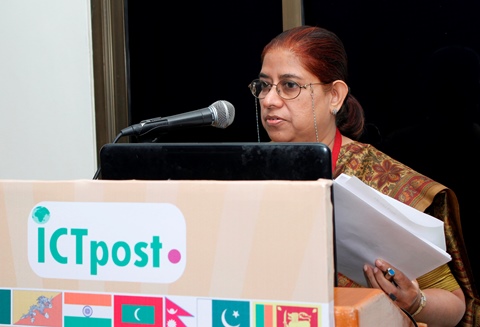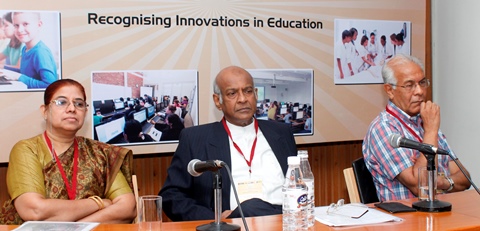Dr. Shakila Shamsu, Former OSD (NEP), Ministery of Higher Education, Gov. of India
Some Facts:
South Asia (SA)has one fifths of the world population.
Has the largest number of people living below poverty line
Economic and social development cannot be achieved without optimizing human resources for which education is the critical factor.
Illiteracy is one of the major causes impeding the development of the vast human resources of SA and the major factor for the region?s economic backwardness and social imbalance.
Twin problems : lack of access and excellence in education.
Enrollment of children of primary school age far below universal level, with high levels of dropout. Situation at the secondary and tertiary level even worse.
SAARC emphasized the importance of promotion of education
Areas of Concern
Quantity- access
Quality- excellence
Disparities- equity & inclusion
Costs- public, private, PPP , student financing
Employability and Entrepreneurship
Collaborations, Research and innovations
Cross border higher education
Technology in and for education
Some facts on Higher Education
Rising demand for higher education not being met.
Need to ensure equity in access.
Involvement of private sector- robust regulation required.
Universities rank poorly on international rankings-need to raise standards and create quality assurance mechanisms
Poor employability of graduates- Disconnect between the market needs and higher education institutions has resulted in high levels of graduate unemployment and underemployment.
Weak governance and low salaries are issues in retaining and attracting the sector’s top talent.
Female representation in leadership is low
New generation of Diaspora and indigenous talent.
Is there a potential for foreign providers to play a role
Higher Education in the region
Despite the diversity in the region, HE systems face similar problems and challenges.
All countries confronted with similar domestic challenges.
Many of the systems are undergoing restructuring in areas – funding, resources, governance , curriculum development & student financing
One of the key developments is the increasing growth of trans- national education and cross-border exchange.
Education is just one area of priority in South Asian economies, competing with several other policy agenda issues.
Education is a public good, hence difficult to liberalise the sector.
Strengths and ChallengesDemographic dividend in an ageing world 12% of population in the year 2011 in 18-24 age group
12.8 million young persons are joining the working class every year
Labour force in India to increase by 32 per cent over the next 20 years, while it will decline by 4.0 per cent in industrialized countries and by nearly 5.0 per cent in China.
Large productive population 75% by 2025
Challenges of Expansion, Equity and Excellence
Need to increase access
Reducing regional, social, gender imbalances
Faculty shortages
Less number of accredited institutions
Low emphasis on research and poor research output
Low employability skills
Female participation UNESCO reports that in South Asia there are just 74 females enrolled in tertiary education for every 100 males.
As a whole, the region has made promising progress in improving women’s access to higher education.
There has been a considerable narrowing of the gap between male and female enrolment at all levels.
Quality of Education
Quality of education a major concern in both the private and public sectors.
Need for specific policy and a transparent, comprehensible set of rules and regulations for private education .
Dearth of effective accreditation and quality assurance mechanisms- Finding viable solutions for credible, independent accreditation bodies is a high priority across the region.
Standards in higher education are variable across the region, but SA as a whole remains well below the average in international rankings.
Retaining talent is an issue in knowledge sectors, and the problem is more acute in higher education in SA- low salary levels
Issues of weak governance.
Transitory nature of leadership-high turnover amongst senior leadership makes it difficult for universities to implement long-term strategies for higher education.
Employability An unfortunate by-product of the low quality of higher education both for the economies and the students themselves is the low employability of graduates who emerge from the universities.
Though there are exceptions, as a general rule, employers in South Asia are more inclined towards graduates from the large public universities.
In particular, there has been criticism of the teaching methodology and students (even at tertiary levels) are not necessarily taught how to conduct independent research
Foreign participation
Policy-makers widely recognise the contribution that foreign providers can offer both to increase capacity and improve quality,
However, each country in the region has a different view regarding the participation of foreign players.
There is a smattering of international universities across South Asia, the involvement of universities is predominantly in the form of collaborations with existing institutions, though not always with the established public universities.
Such arrangements currently exist in all countries in the region.
Common goals and strategies
Shared core objectives :
o Strengthen and upgrade the quality of higher education on offer
o Expand capacity ? including through private or non-state higher education provision, and better regulation of the sector
o Expand accessibility
oImprove and build the independence of accreditation and quality assurance systems
o Develop research, especially in science and technology
oImprove standards of governance and enhance institutional autonomy
oLeverage information and communications technology to expand accessibility to institutions and resources -mobile penetration, MOOCs
o Ensure the marketplace relevance of degrees and improve employability levels for graduates
Changing landscapes in education
Free and compulsory elementary education -Rights based approach and student entitlements;
Shift from literacy and basic education ?to secondary, higher, ?technical and professional education;
Emphasis on quality at all levels;
Importance of skills /vocational education and equivalence with formal education qualifications;
Charter a path for socially and regionally equitable ?education ;
Need for innovative ways of student financing;
Empowering teachers, address teacher shortages at all levels;
21st Century challenges- globalization and liberalization ;
Education in human values , fostering social responsibility , engaging with community;
Evolve relevant curriculum with changes in learning theories and pedagogic practices;
Importance of use of technology in education ;
Lifelong education through distance and open education;
Multi-disciplinary and ?inter-disciplinary nature of learning and knowledge;
Focus on research & innovation;
Participation of local bodies and civil society;
Autonomy & Accountability;
Efficient use of public resources and ways of enhancing private investment and funding.








